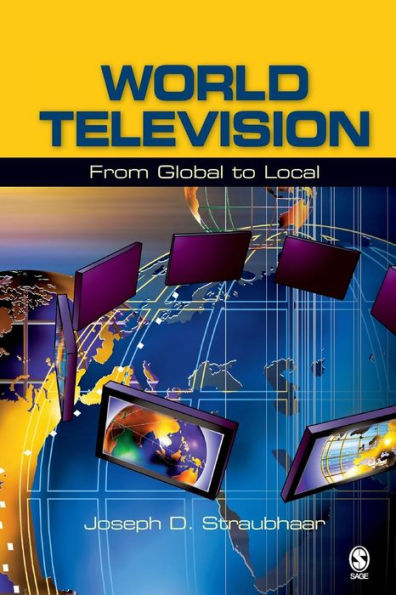World Television: From Global to Local / Edition 1 available in Paperback, eBook

World Television: From Global to Local / Edition 1
- ISBN-10:
- 0803954638
- ISBN-13:
- 9780803954632
- Pub. Date:
- 05/18/2007
- Publisher:
- SAGE Publications
- ISBN-10:
- 0803954638
- ISBN-13:
- 9780803954632
- Pub. Date:
- 05/18/2007
- Publisher:
- SAGE Publications

World Television: From Global to Local / Edition 1
Buy New
$95.00Buy Used
$47.10-
-
SHIP THIS ITEM
Temporarily Out of Stock Online
Please check back later for updated availability.
-
Overview
Key Features
• Draws upon both international communication and cultural studies perspectives: Presents a new model is presented that attempts to move beyond the current controversies about imperialism and globalization.
• Looks at historical patterns: Historical patterns across cultures and countries help compare where television has been and where it is going.
• Takes a contemporary focus: Uses of technology, flows and patterns of program development, genres of television, the interaction of producers and audiences, and patterns of audience choice among emerging alternatives are examined.
• Explores how the audience for these evolving forms of television is structured: The effects of these forces or patterns of television have on both cultural formations and individual identities are identified.
Intended Audience
This is an excellent text for advanced undergraduate and graduate courses in Globalizatiion and Culture, Global Media, Television Studies, Television Criticism, and International Media.

Product Details
| ISBN-13: | 9780803954632 |
|---|---|
| Publisher: | SAGE Publications |
| Publication date: | 05/18/2007 |
| Series: | Communication and Human Values Series |
| Edition description: | First Edition |
| Pages: | 312 |
| Product dimensions: | 6.00(w) x 9.00(h) x (d) |
About the Author
Amon G. Carter Centennial Professor of Communication and Director of Media Studies
E-mail: jdstraubhaar@mail.utexas.edu
Office: CMA 6.120
Phone: 512-471-5304
Ph.D., Fletcher School of Law and Diplomacy, Tufts University, 1981.
ARTICLE AND INTERVIEW FEATURING JOE STRAUBHAAR
Professor Joseph D. Straubhaar is the Amon G. Carter Centennial Professor of Communications in the Department of Radio-TV-Film at the University of Texas at Austin. He is also Associate Director for International Programs of the Telecommunication and Information Policy Institute at the University of Texas. He was the Director of the Center for Brazilian Studies within the Lozano Long Institute for Latin American Studies, 2003-2006.
His primary teaching, research and writing interests are in global media, international communication and cultural theory, information societies and the digital divide in the U. S. and other countries, and global television production and flow. His graduate teaching includes media theory, global media, comparative media systems, international telecommunications systems, Latin American media, and research methods. His undergraduate teaching covers the same range plus introduction to mass communication and the information society. He does research in Brazil, other Latin America countries, Europe, Asia and Africa, and has taken student groups to Latin America and Asia. He has done seminars abroad on media research, television programming strategies, and telecommunications privatization. He is on the editorial board for the Howard Journal of Communication, Journal of Broadcasting and Electronic Media, Studies in Latin American Popular Culture, and Revista INTERCOM.
His book, World Television from Global to Local, was published by Sage in 2007. A revised 6th edition of his textbook with Bob La Rose, Media Now, was just published by Wadsworth. He has an edited book, The Persistence of Inequity in the Technopolis: Race, Class and the Digital Divide in Austin, Texas, forthcoming from University of Texas Press. He had an edited book with Othon Jambeiro, Políticas de informação e comunicação, jornalismo e inclusão digital: O Local e o Global em Austin e Salvador (Information and communication policy, journalism and digital inclusion: The local and global in Austin and Salvador); Federal University of Bahia Press: 2005. Recent articles and book chapters include:
"Broadcast Research in the Americas: Revisiting the Past and Looking to the Future. Journal of Broadcasting and Electronic Media, Vol. 50(3), 368-382, September 2006.
"Multiple Proximities between Television Genres and Audiences: The Schism between Telenovelas' Global Distribution and Local Consumption." Gazette. 67(3): 271-288.
"(Re)asserting National Media and National Identity Against the Global, Regional and Local Levels of World Television." In Meenakshi Gigi Durham and Doug Kellner, Eds. Media and cultural studies: Keyworks, Revised Edition. Malden, Mass. Blackwell Publishers, 2005.
"The centrality of telenovelas in Latin America life: Past tendencies, current knowledge, and future research." Global Media Journal, Vol. 2, Spring 2003.
"Choosing National TV: Cultural Capital, Language, and Cultural Proximity in Brazil." In Michael Elasmar, ed. The Impact of International Television: A Paradigm Shift. Lawrence Earlbaum Associates, 2003.
He has published numerous articles and essays on global media, digital inclusion, Brazilian television, Latin American media, comparative analyses of new television technologies, media flow and culture, and other topics appearing in a number of journals, edited books, and elsewhere.



